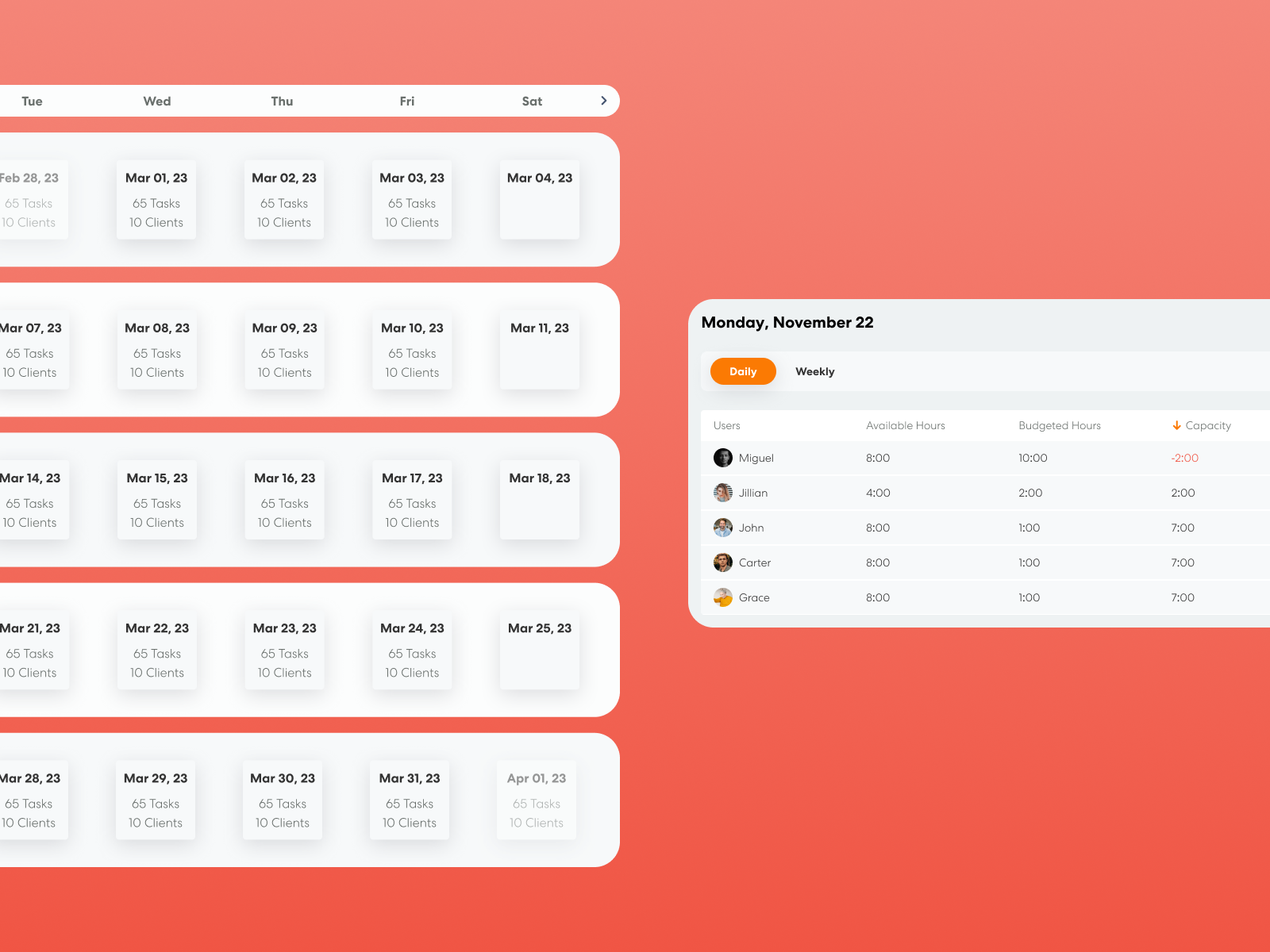The Accounting Firm's Guide to Capacity Management

What You Think Your Team Can Handle vs. What the Data Says
Without proper capacity management, even the most competent, capable, and motivated accounting teams can run into burnout, inefficiencies, and stalled growth. Unfortunately, many firms rely on gut instinct or historical precedent when it comes to planning workloads—and this approach is often misleading. To ensure your team stays on track, efficient, and ready to scale seamlessly, a great capacity management plan is essential.
Levvy was built by accountants, for accountants—so we’re no stranger to the ins and outs or the pitfalls and triumphs of managing an accounting team. That’s why we put together this guide to nailing your capacity management processes. Below, we’ll break down the true cost of poor capacity management, how to measure it, and how Levvy helps firms solve it with ease.
The Hidden Costs of Poor Capacity Management
Poor capacity management isn’t just frustrating for your team—it can be costly in more ways than one.
Burnout & Turnover
One of the greatest risks of poorly managed capacity is a burned out team. When workloads are underestimated, team members end up with more on their plate than they can handle. This leads to drops in morale and spikes in burnout. And that doesn’t just affect the mental health of your employees. Replacing burned-out team members can be expensive, time-consuming, and, in general, a real headache. The last thing you want is to let that hold you back when you should be focusing on delivering high-value work and scaling your business.
Recurring Bottlenecks
At Levvy, we know that workflows are the beating heart of any great accounting firm—and well-oiled workflows rely on accurate data when it comes to team capacity. Without full visibility into the work your team is actually doing, your workflows will break down in the same places again and again. These bottlenecks lead to missed deadlines and tanked client satisfaction.
Wasted Resources
Poor capacity management doesn’t only put you at risk of an overworked, burned out team; overestimating what your team can do can be just as dangerous as underestimating. Miscalculating capacity is likely to result in issues like underutilized staff, uneven workloads, and lots of extra time spent on admin—all of which can cost you a great deal of wasted money. The best way to avoid these pitfalls is to ensure full visibility and accurate capacity data.
Unscalable Pricing
Firms can’t confidently adopt fixed-fee or value-based pricing models without real-time visibility into the actual cost of delivering their services. Without a clear view of task-level effort and team bandwidth, pricing is a guessing game. When you don’t have accurate, data-driven insights into how long services actually take and how much capacity your team has, you could end up undercharging on complex clients, overcharging on simpler ones, and ultimately, eroding profit.
How to Measure & Plan for Capacity
Once you recognize the cost of poor capacity management, the next question is: how do you get it right?
Capacity planning is all about balancing workloads, forecasting demand, and optimizing resources so you can deliver excellent service to your clients without burning out your team. When you nail your capacity management, you get better margins, happier employees, and faster growth.
Capacity is the total amount of work your team can take on within a given period—but it can be tricky to evaluate. To get an accurate snapshot, you’ll need to take the following into account:
- PTO and holidays
- Administrative and internal work
- Meetings and training
- Experience level and efficiency of each team member
For example, a senior accountant may complete certain tasks in half the time it takes a junior team member—so two people with the same availability on paper may have very different real-world capacity.
Track the Right Metrics
Once you account for the above nuances, it’s time to start tracking the data. Keeping an eye on the following metrics will help you spot problems, identify areas for improvement, and plan smarter:
- Hours Logged vs. Capacity Available: Comparing your team’s capacity to the hours that are actually being logged is the best way to spot both overwork and underutilization. If your staff is consistently logging more time than they have capacity for, that’s a red flag for burnout. If team members are under-booked, that’s wasted potential—and a chance to rebalance.
- Task Complexity and Time-to-Completion: Not all tasks are created equal. Some tax returns take two hours; others take twelve. Understanding how long services actually take allows for better forecasting, task delegation, and pricing. Over time, you can use historical data to make more accurate workload predictions.
- Staff Utilization Rates: This shows how much of each team member’s time is spent on billable vs. non-billable work. A consistently low utilization rate could indicate too much admin work or under-scoping of billable time. Knowing your baseline helps you make data-backed hiring and pricing decisions.
- Capacity vs. Demand Forecasting: Compare your team's available hours to all upcoming work. This allows for proactive staffing plans to stay ahead of the game and on track to thrive—whether that means bringing in extra help, pushing timelines, or reprioritizing work.
When a Plan Isn’t Enough, It’s Time for a Reset
Even with the best metrics in place, sometimes your workflows hit a wall—burnout spikes, deadlines slip, and nobody knows where the bottleneck is coming from. That’s when it’s time for a Capacity Reset.
Levvy’s 90-Day Capacity Reset Plan includes five key steps to help your firm reclaim control:
- Capacity Audit (Weeks 1–2): Take stock of workload visibility, time tracking, task ownership, and capacity forecasting. Use Levvy to instantly surface who’s overbooked, underutilized, or blocked.
- Engage the Team (Weeks 3–5): Run pulse surveys and async workshops to understand blockers, inefficiencies, and overload from your team’s perspective.
- Map Workflows (Weeks 6–8): Use Levvy’s customizable workflow tools to document and redesign processes across onboarding, compliance, reporting, and more—smoothing out SOPs and clarifying handoffs.
- Pilot New Rhythms (Weeks 9–12): Roll out your updated systems with a pilot team. Automate onboarding steps, centralize updates, and run weekly async check-ins using Levvy.
- Retrospective (Week 12+): Reflect on wins, spot areas still in progress, and lock in your new rhythm with recurring rituals and dashboard reviews.
Check out our blog post to get a deeper dive into our 5-Part Framework To Reset Your Team’s Capacity.
.png)
Why Real-Time Data Is a Game-Changer
Most firms plan capacity once a year—maybe quarterly, if they’re lucky. But in the modern accounting world, client demands, staff availability, and internal priorities are constantly shifting. Static plans, spreadsheets, and gut checks aren’t going to cut it. You need real-time data.
When you leverage live visibility into everything your team is working on, where they have bandwidth, and where bottlenecks are popping up, you can make smarter decisions before it’s too late—whether that means reassigning work when someone calls in sick or shifting timelines when deliverables are delayed.
Levvy gives you 100%, real-time visibility. That’s part of what makes our platform such a game-changer.
How Levvy Helps Accounting Firms Master Capacity
You don’t have to handle capacity management on your own. We built Levvy to help you take control, ignite efficiency, and stay on track to scale your firm with ease.
Here’s how Levvy lets you master capacity with confidence:
Time Tracking
The first step to masterful capacity management is having accurate insight into how your team is spending their time. Levvy’s automatic time tracking makes it a breeze to understand how long tasks actually take across clients, services, and staff.


Real-Time Capacity Insights
Levvy’s capacity insights allow you to see accurate, precise team availability in real time, not just in spreadsheets. That way, you can identify overworked staff before burnout sets in.

Bulk Task Reassignment
Take the headache out of PTO and sick days—and easily jump into action when overwhelm arises. With Levvy, you can easily reassign tasks in bulk, so it’s easier than ever to make dynamic adjustments as projects shift.

Custom Work Hours
To get an accurate capacity picture, it’s crucial to account for dynamic workloads. Not everyone works 40 hours each week—especially in the modern accounting world. That’s why Levvy lets you set custom work hours for part-time, seasonal, and flexible schedules.

Capacity Management = Faster Growth
It’s time to stop letting your gut instinct run the show when it comes to capacity planning. Accurate data and effective management isn’t just an operational fix—it’s a growth strategy. Because when workloads reach their sweet spot, teams run smoother than ever. That’s when the magic happens and firms flourish.
Ready to understand your team’s capacity like never before, protect your people, and price smarter? Get started with Levvy today.

.png)
.png)




